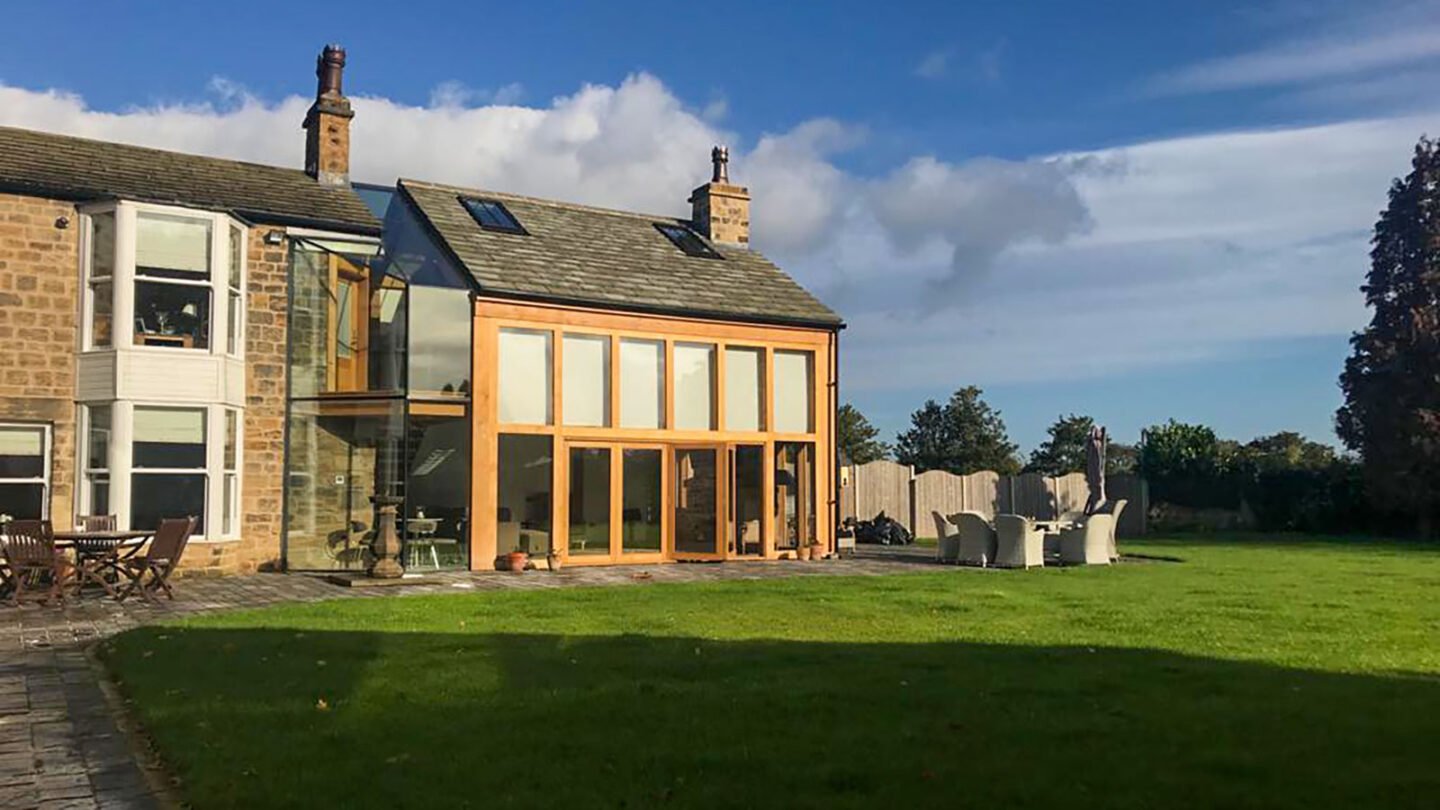
oakbydesign
01423 593 794


Adrian was looking for inspiration for a large oak frame extension to be added to his period home in a village near Wakefield. He visited the annual Homebuilding & Renovating Show in Harrogate a few years ago, to try and find it!
We have been exhibiting at the show for a number of years. It's a great place for potential clients and suppliers to meet. Adrian met with Jamie Winspear on their stand at the show. He asked lots of questions, and they discussed his potential forthcoming project in detail.
A few months later, after appointing an architect, he contacted Jamie again.
It transpired the architects had also recommended us to him, so it felt like a good match!
Adrian was looking to extend the family home, a detached, Victorian house. He didn’t want the extension to ‘match’ his existing home, he wanted a contrast. He wanted the new building to look contemporary and to highlight the 2 different periods of building.
The design that was finally decided on was a double height glazed oak frame extension to the side of the existing building but it was to stand forward of the original house.
Jamie recommended a suitable builder to the client, and the project started!
Where the buildings adjoin, a 2 storey glazed atrium sits within the corner and a glazed roof runs the depth of the building. A staircase leads to the upper level of the original part of the home. A mezzanine level sits against the original part of the house providing a great area to sit and admire the view from the glazed atrium.
The 2-storey high oak frame extension to the front and side of the property, floods light into the new building and bi-fold doors open on to the garden.
Providing the framework, the roof trusses and purlins, the oak timbers take a prominent position within this large room.
The majority of the new build oak frame extension is an open, family entertainment room with a full height, brick built chimney on the far wall. A cosy wood-burning stove has been installed for the colder evenings.
The back of the building doesn’t have glazing, but light floods in through 9 solar powered, conservation roof lights.
The ‘chunky’ oak stairs are bespoke oak covers made to fit around a pre-fabricated steel framework. Glass balustrades give an open, light, contemporary feel to the building and LED lights, fit into each step. These cast a beautiful glow around the stairs in an evening.
A fabulous glass light fitting within a metal frame creates a further contemporary addition to the home.
Once the building work was finished, Adrian and his family settled into the new extended home. The client being overwhelmed with his new home thrilled us!
He said ‘the oak frame extension is wonderful. When I sit and relax in the room in the evening it just makes me smile’.
The ‘icing on the cake’ for Jamie and the team was being shortlisted in the West Yorkshire LABC Building Excellence Awards. This was for The Best Extension or Alteration to an Existing Building .
On 22nd September, the digital awards ceremony took place.
Winner of the category – Oak By Design!
A couple of years later there was an another addition to the home. A fabulous Oak pool building.
This has created the perfect family home for Adrian and his family.
Oak conservatories have emerged as a quintessential architectural addition, elegance and sophistication. This timeless structure seamlessly blends with any landscape, augmenting the aesthetics of both traditional and contemporary settings. The unparalleled charm of oak conservatories lies in their ability to harmonise with nature, creating a sanctuary that encapsulates tranquility.
One notable advantage of oak conservatories is their exceptional durability. Crafted from robust oak timber, these structures exhibit remarkable strength, ensuring longevity that surpasses conventional building materials. The solid construction not only withstands the test of time but also serves as an enduring testament to masterful craftsmanship.
Moreover, oak conservatories offer an abundance of natural light through their expansive glazing panels. These ethereal spaces become sanctuaries bathed in a soft luminosity during daylight hours, fostering a connection with the outdoors while providing an immersive experience within the comfort of one's home.
Furthermore, oak conservatories seamlessly merge indoor and outdoor living spaces, offering a seamless transition between the two realms. This spatial integration fosters a sense of harmony and unity between architecture and nature—a symphony where boundaries dissolve into nothingness.
In conclusion, oak conservatories are more than mere architectural marvels; they embody an embodiment of grace and beauty that transcends time. Their durability, ability to invite abundant natural light, and seamless merging of indoor and outdoor spaces make them an exquisite choice for those seeking to create a haven within their homes—a sanctuary where one can escape the chaos of everyday life and immerse themselves in serenity offered by nature's embrace.
Green oak and air-dried oak are two distinct types of timber that differ in their characteristics. Understanding these differences is crucial for anyone involved in the construction or woodworking industry.
When comparing green oak to air-dried oak, one can draw an analogy with the concept of aging wine. Just as wine needs time to mature and develop its unique flavors, green oak requires a seasoning process to achieve optimal quality.
During the seasoning process, green oak gradually loses moisture content through natural drying methods. This reduction in moisture not only improves the stability of the wood but also prevents excessive movement and shrinkage over time. It is comparable to how aging wine develops complexity while maintaining stability.
On the other hand, air-dried oak undergoes a different drying method. Once cut into sizeable timber pieces, it is left outside to dry naturally over an extended period. The exposure to open air allows for gradual moisture loss through evaporation, resulting in lower moisture content compared to green oak.
The metaphorical comparison between green oak and aging wine helps illustrate how both processes require patience and time for desirable outcomes. Just as aged wine showcases its refined qualities after years of maturing, air-dried oak represents a stable and reliable material due to its prolonged seasoning period.
In summary, understanding the distinction between green oak and air-dried oak is essential when choosing timber for construction purposes. Whether opting for freshly felled or naturally dried wood, each has its advantages based on specific project requirements and desired characteristics.
In the realm of building construction and design, the implementation of effective insulation systems plays a pivotal role in ensuring optimal thermal performance. One such prominent solution is double glazing, which has gained significant attention due to its ability to augment energy efficiency within enclosed spaces. This article aims to explore the fundamental characteristics and benefits of double glazing as a means of retaining heat while preventing cold air infiltration.
Double glazing, also known as a double glazed unit (DGU), comprises two glass sheets that are separated by a spacer bar. The resulting air gap between these panes acts as an insulating barrier, enhancing the window's thermal resistance properties. By effectively trapping air or employing insulating gas fills, this innovative system creates a protective shield against external temperature fluctuations.
The concept of double glazing can be likened to a delectable sandwich - two layers of bread encasing an enticing filling. In this analogy, the glass sheets represent the sturdy bread slices that protect and encapsulate the room's interior from external influences. Meanwhile, the air gap serves as the tantalizing filling that ensures utmost comfort by preventing heat loss and cold intrusion.
As discerning building experts, it is crucial to acknowledge the significance of incorporating efficient insulation solutions like double glazing into our designs. Through their exceptional thermal insulation capabilities, these units facilitate energy conservation by minimizing heat transfer across windows. By utilizing metaphors such as sandwiches with delightful fillings, we can evoke emotional responses in our audience while maintaining an objective academic writing style throughout our discourse on this essential subject matter.
Telephone: 01423 593 794
Locksley Park
Blind Lane
Tockwith
YORK YO26 7QJ
Opening Times:
Mon to Fri - 9.00am to 5.00pm
Bank Holidays - Closed
Christmas 2025- TBC
Oak By Design is the trading name of:
Oak By Design Ltd.
Reg Number: 04384416
VAT Number: 664 8012 33